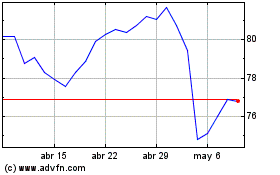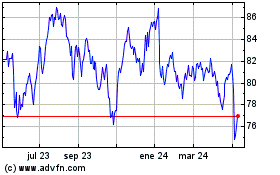By Andrew Scurria
In the decade since R. Allen Stanford's international financial
empire was exposed as a fiction, investors in his Ponzi scheme have
recouped just a tiny fraction of the life savings many of them
lost.
Now a small group of individuals, backed by hedge funds, is
making a last-ditch effort to recover money from five banks that
they contend turned a blind eye to Mr. Stanford's fraud. In a
lawsuit filed in Dallas federal court on Friday, these investors
alleged that the banks "aided, abetted and conspired" with Mr.
Stanford to steal from investors and that "their close profitable
relationship with such a wealthy, high-profile customer led them to
callously ignore R.A. Stanford's fraud."
The five banks they sued on Friday are HSBC Bank PLC,
Toronto-Dominion Bank, Bank of Houston, Trustmark National Bank,
and Societe Generale Private Banking. Most of these institutions
had long-term relationships with Mr. Stanford and his entities, and
those ties gave them insights into the fraud as it was happening,
the investors allege.
In addition to filing the new lawsuit, investors in Stanford
have lobbied lawmakers in recent months, met with Securities and
Exchange Commission Chairman Jay Clayton and pressed for the return
of frozen overseas assets, according to people familiar with the
matter.
Since Mr. Stanford's arrest and the collapse of Stanford
International Bank Ltd. in 2009, what remains of his far-flung
financial operation has been wound down by lawyers and consultants
in Antigua and Dallas, where court-appointed liquidators have sold
assets, sued alleged beneficiaries of the fraud and distributed
proceeds across roughly 18,000 victims.
But unlike account holders at Bernard Madoff's phantom
investment firm, Mr. Stanford's U.S. victims stand out for how
little they have recovered. The judge overseeing the receivership
has authorized $272 million in distributions, compared with the
more than $5 billion lost by depositors.
That comes out to roughly 4.5 cents on every dollar in losses.
By contrast Mr. Madoff's customers have gotten back roughly
two-thirds of the $17.5 billion they lost, with individual claims
up to $1.5 million satisfied in full. The schemes imploded two
months apart as the global financial crisis peaked.
Blaine Smith, of Baton Rouge, La. was enjoying early retirement
in 2009 from a career working for Exxon Mobil Corp., building
houses and running a TCBY franchise on the side. He lost more than
$1 million on IRAs, certificates of deposit and other Stanford
group investments that evaporated when the institutions collapsed,
costing him his home, boat and motorcycle and all but $150,000 of
his life savings. His wife worked for the state a decade longer
than they planned; he went back to work as a construction
superintendent.
"It ruined our lives," Mr. Smith said. "I literally cried for
the first 365 days. I would cry going to work and going back, and
pretty much all day long."
Mr. Smith, 61, never sold his claim to an outside investor. The
best offer -- 14 cents on the dollar -- was too low for him to
bite. Instead, he has spent the past decade hoping lawsuits would
eventually dig up enough money to pay him more. Mr. Smith isn't
part of the lawsuit.
Kevin Sadler, a lawyer for the receiver, acknowledged that the
pace of recoveries have been "frustratingly slow," in part because
U.S. government prosecutors didn't generate recoveries for victims
to the extent it did for those who invested with Mr. Madoff.
Mr. Madoff's account holders were deemed eligible for insurance
coverage from the Securities Investor Protection Corp., an industry
association created by Congress that maintains a special fund to
cover the first $500,000 of losses for customers of failed
brokerages. SIPC also bankrolled a legal campaign by Madoff
liquidating trustee that dug up more than $13 billion for
creditors.
No such coverage was available to Mr. Stanford's victims, which
also meant the legal fees for cleaning up his fraud had to be paid
out of money that would otherwise go to victims. As of October 31,
those fees and expenses totaled $224.2 million, according to court
records.
"When you're not able to be outspent, that improves your ability
to resolve cases successfully," said Mark Kornfeld, a lawyer who
worked for years with the Madoff trustee.
More money is expected to come in for Stanford investors. The
receiver is seeking court approval to distribute an additional $200
million in settlements he reached last year, while a pending
judgment against Colorado billionaire Gary Magness could bring in
another $125 million, Mr. Sadler said.
But the banks that moved money in and out of Mr. Stanford's
companies are disputing they owe anything. The receiver has already
sued them.
SocGen also holds roughly $160 million in assets linked to Mr.
Stanford in Switzerland, claiming in Swiss court that it has the
right to use the funds to protect itself against potential claims.
Senator Bill Cassidy (R, La.) demanded that the money be returned
in a meeting last month with SocGen's attorneys, alleging it "aided
and abetted Stanford's banking outside the United States." A SocGen
spokesman said it was "carefully reviewing" the senators'
concerns.
The other banks either declined to comment about Friday's
lawsuit or didn't immediately respond to queries.
Backing the investors in the lawsuit are hedge funds that bought
out some of the victims' claims in the hope of turning a profit
themselves.
Plaintiffs include Contrarian Capital LLC, CarVal Investors LLC,
Whitebox Advisors LLC and Foxhill Capital Partners LLC --
investment funds that purchased victims' claims -- betting the
receiver would return additional proceeds from Mr. Stanford's
crimes over time.
Mr. Stanford is serving a 110-year prison sentence in central
Florida, 50 miles northwest of Orlando, after his 2012 conviction
on 13 felony counts. He has remained unrepentant, petitioning
several courts from prison to free him and publishing a 789-page
book that is available on Amazon, claiming he was made a scapegoat
by prosecutors.
--Gretchen Morgenson and Dave Michaels contributed to this
article.
Write to Andrew Scurria at Andrew.Scurria@wsj.com
(END) Dow Jones Newswires
May 04, 2019 08:14 ET (12:14 GMT)
Copyright (c) 2019 Dow Jones & Company, Inc.
Toronto Dominion Bank (TSX:TD)
Gráfica de Acción Histórica
De Mar 2024 a Abr 2024

Toronto Dominion Bank (TSX:TD)
Gráfica de Acción Histórica
De Abr 2023 a Abr 2024
